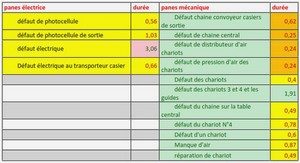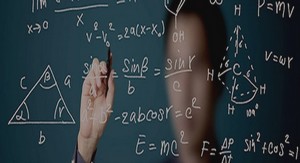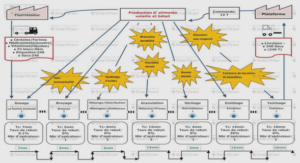Exponential stabilization at any rate of a bifluid interface with surface tension in a torus
Previous works
To the best of the author knowledge, stabilization result for system (3.1 .1) does not exist. However, problem of free interfaces with viscous fluids have received a wide attention over the last decades. The pioneering work of Solonnikov [40, 41, 42, 43, 44] deals with a one phase problem of a finite isolated mass of incompressible viscous fluid bounded by a free boundary. At the beginning, he considered the problem without surface tension: he first proved the local solvability in Hölder space in [40] in dimension 3 without surface tension and a global solvability in the Sobolev space W2,1 p in dimension d ∈ {2, 3} with p > d in [43]. He then considered surface tension effect and obtained in dimension 3, local existence in Sobolev spaces Hr,r/2 with r ∈ (5/2, 3) in [41] and global existence in the same space for small initial data and an initial free surface close to the ball in [42, 44]. At the same time, Beale [7, 8] considered the one phase problem of surface waves describing the motion of one layer of fluid having a non-compact free interface in dimension 3. He began by considering the model without surface tension in [7]. He proved three main results : local existence of solutions in Sobolev space Hr,r/2 with r ∈ (3, 7/2), existence of solutions in large times for small data, and he also proved that one plausible extension of the second assertion to an infinite time interval is false. So far, these systems are solved only by means of Lagrangian coordinates. In [8], Beale used a different change of unknowns to deal with the surface waves problem including surface tension. He showed a small-data global existence and uniqueness of solution in Hr,r/2 with r ∈ (3, 7/2) and proved that slightly after the initial time, the solution becomes arbitrarily smooth and satisfies the equations in a classical sense. Numerous works have followed the two pioneers approaches of Solonnikov and Beale. Beale and Nishida [9] proved that global solution of surface waves with surface tension of [8] decay algebraically in time: the free surface tends to equilibrum at a rate t −1/2 and the velocity field at a rate t −1 . Sylvester [45] proved that if the initial data are sufficiently regular and small and satisfy some compatibility conditions, then there exists a global solution in Hr,r/2 with r ∈ (9/2, 5) of the surface waves problem without surface tension of [7], the solution being defined on an infinite time interval and being unique on any finite time interval. Allain in [2], Tani in [48] and Tani and Tanaka in [49] worked in Beale’s configuration of surface waves but with Sobolev approach that enables to get solutions in Hr,r/2 with r ∈ (5/2, 3). In [2], Allain showed a local existence in dimension 2 taking the surface tension effect into account. This result was generalized in dimension 3 by Tani in [48]. In dimension 2, Tani and Tanaka [49] proved existence at any time T > 0 for small data with and without surface tension. In the case of surface waves with surface tension, Bae [5] proved small-data global well-posedness using energy methods rather than the Beale-Solonnikov framework. Nishida et al [33] and Hataya [28] considered the problem of surface waves in a periodic case. Nishida et al [33] took the surface tension effect into account and in the spirit of [8] and [9], they proved small-data global existence and uniqueness in Sobolev space Hr,r/2 with r ∈ (3, 7/2) and they showed that slightly after the initial time, the solution becomes arbitrarily smooth and satisfies the equations in a classical sense. Lastly, they proved the exponential decay of the solution by means of an energy method. Hataya [28] did not consider surface tension and proved a small-data global existence on an infinite time interval in Hr,r/2 with r ∈ (5, 11/2). In the case of one layer without surface tension, Guo and Tice proved a local well-posedness for horizontally periodic or horizontally infinite domains in [26], a global well-posedness in infinite extent domain with an algebraic decay in time in [25] and a global well-posedness in periodic domain with an almost exponential decay in time in [24]. One can also find existence of weak solutions in [1, 11]. The literature on one phase free interface problems being very rich, the above list is subjective. Results on two phase fluid models are more recent. In the spirit of the work of Solonnikov on the one phase problem of a finite isolated mass of incompressible viscous fluid bounded by a free boundary, Denisova [12, 14, 13] and Denisova and Solonnikov [17, 18, 19] have been interested in the problem in dimension 3 of a drop of incompressible viscous fluid in another non-miscible fluid assumed to be incompressible and viscous, taking surface tension effects into account. In [12, 17], they proved a priori estimates for solutions in Sobolev spaces which lead to a result of local existence and uniqueness in Hr,r/2 with r ∈ (5/2, 3) in [14] . In [13, 18], they proved existence, uniqueness and estimates for the linear system in Hölder spaces which lead to a local existence and uniqueness result in Hölder spaces in [19]. Meanwhile, Tanaka [46, 47] has been interested in the same model but in a bounded domain. He proved local well-posedness in Hr,r/2 with r ∈ (7/2, 4) in [47] and global well-posedness in Denisova’s Sobolev framework and with non constant densities in [46]. Later, Denisova has been interested in the same problem without surface tension in a bounded domain, and proved local existence and uniqueness, and small-data global existence in Hölder space in [15] and in Sobolev space in Hr,r/2 with r ∈ (5/2, 3) in [16]. Furthermore, she proved that the global solution decays exponentially in time.
Main results
Our main result is expressed in a fixed domain. This part is divided as follow: in Section 3.2 .1, we express system (3.1 .1) in a fixed domain; in Section 3.2 .2, the main result on system (3.2 .3) is stated; in Section 3.2 .3, we give our main result on the linear problem; in Section 3.2 .4, we present ideas of the proof and the main difficulties and novelties; lastly, in Section 3.2 .5, we introduce the notations used in the article. 3.2 .1 Change of unknowns The main purpose of this change of unknowns is to express system (3.1 .1) in a fixed domain. Let first denote by ke a lifting of k in Ω such that ke = 0 on Γd that will be rigorously defined later (see Lemma 3.7 .2) and let X(t, ·) : Ω → Ω (y 0 , yd) 7→ Remark 3.2 .2. The parameter δ > 0 of (3.2 .7) will be chosen small enough to guarantee that X0 defined in (3.2 .1) for ke = h0 is invertible, so that (3.2 .8) makes sense. Remark 3.2 .3. In our mathematical framework, the control g cannot be found in a feedback form without introducing compatibility conditions between the feedback and the initial data (u0, h0). However, even in weaker regularity settings, these compatibility conditions cannot be avoided in the 3 dimensional case as discussed for example in [3]. Therefore, the control g is found in the form of an integrator g 0 + Λg = f, g(0) = 0,



